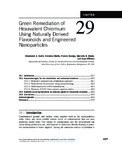Green Remediation of Hexavalent Chromium Using Naturally Derived Flavonoids and Engineered Nanoparticles

View/
Date
2014Author
Omowunmi, A. Sadik
Okello, Veronica
Osonga, Francis
Omole, Marcells A.
’Owino, Isaac K
Metadata
Show full item recordAbstract
Contaminated ground- and surface water supplies such as the municipalities, wells, lakes, and rivers exhibit various levels of contamination that can pose numerous health risks. The release of contaminants into the environment can occur during production, use, and disposal of chemicals, thereby leading to potential contamination of water supplies. Among the numerous sources of pollution is treated wastewater, which is reinjected into groundwater aquifers for indirect reuse. In order to reach drinking water quality standards, surface water typically requires both filtration and disinfection because of its exposure to the environment and the higher potential for contamination. Industry and municipalities use about 10% of the globally accessible runoff and generate a stream of wastewater that flows or seeps into rivers, lakes, groundwater, or the coastal seas [1]. These wastewaters contain numerous chemical compounds in varying concentrations. About 300 million tons of synthetic compounds used in industrial and consumer products partially find their way into natural waters. Additional pollution comes from diffuse sources such as agriculture, where 140 million tons of fertilizers and several million tons of pesticides are applied each year [2]. The input of 0.4 million tons of oil and gasoline components through accidental spills represents yet another important source of water pollution. Other notable sources of contamination include the intrusion of salty water into groundwater due to overexploitation of aquifers, the human-driven mobilization of naturally occurring geogenic toxic chemicals, including heavy metals and metalloids, and the biological production of toxins and malodorous compounds.
